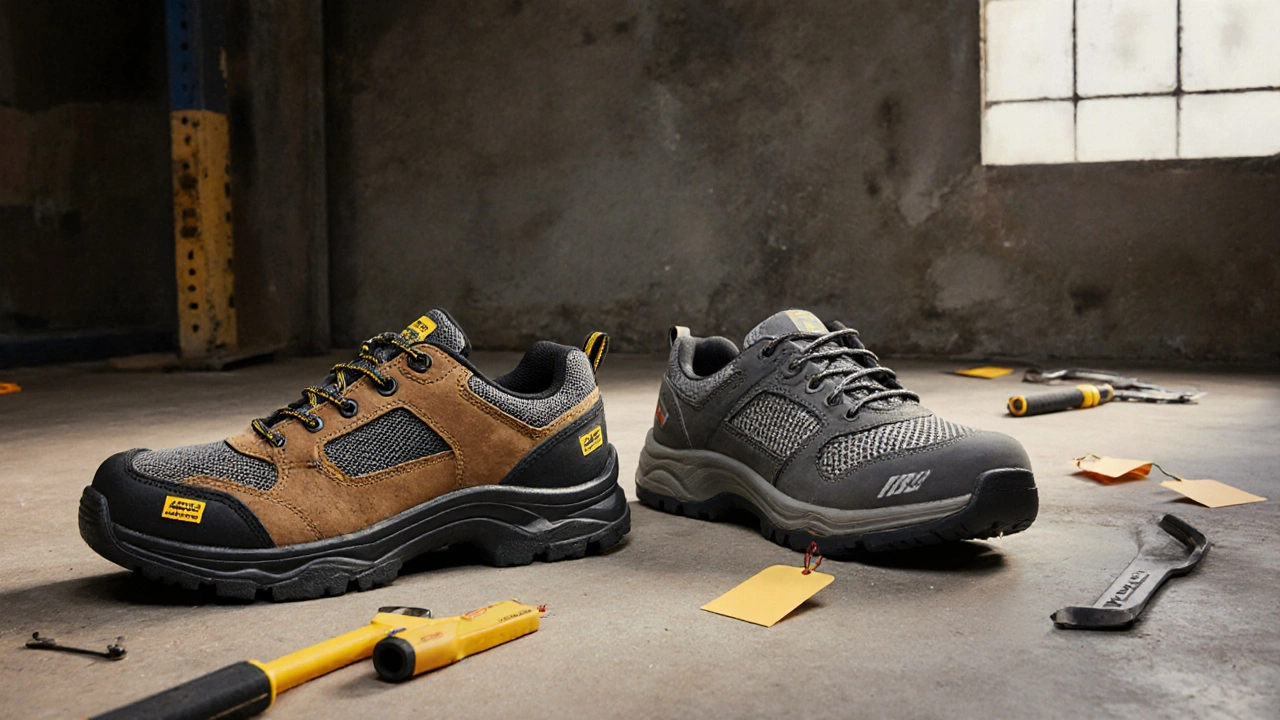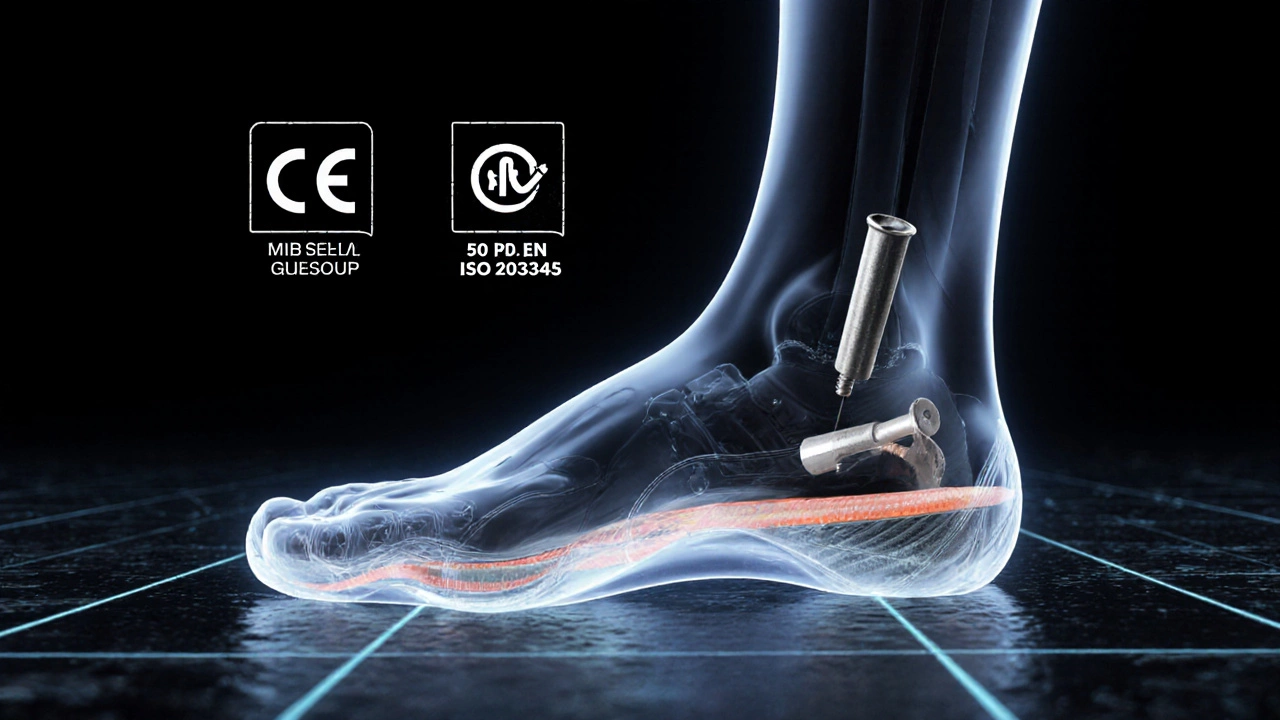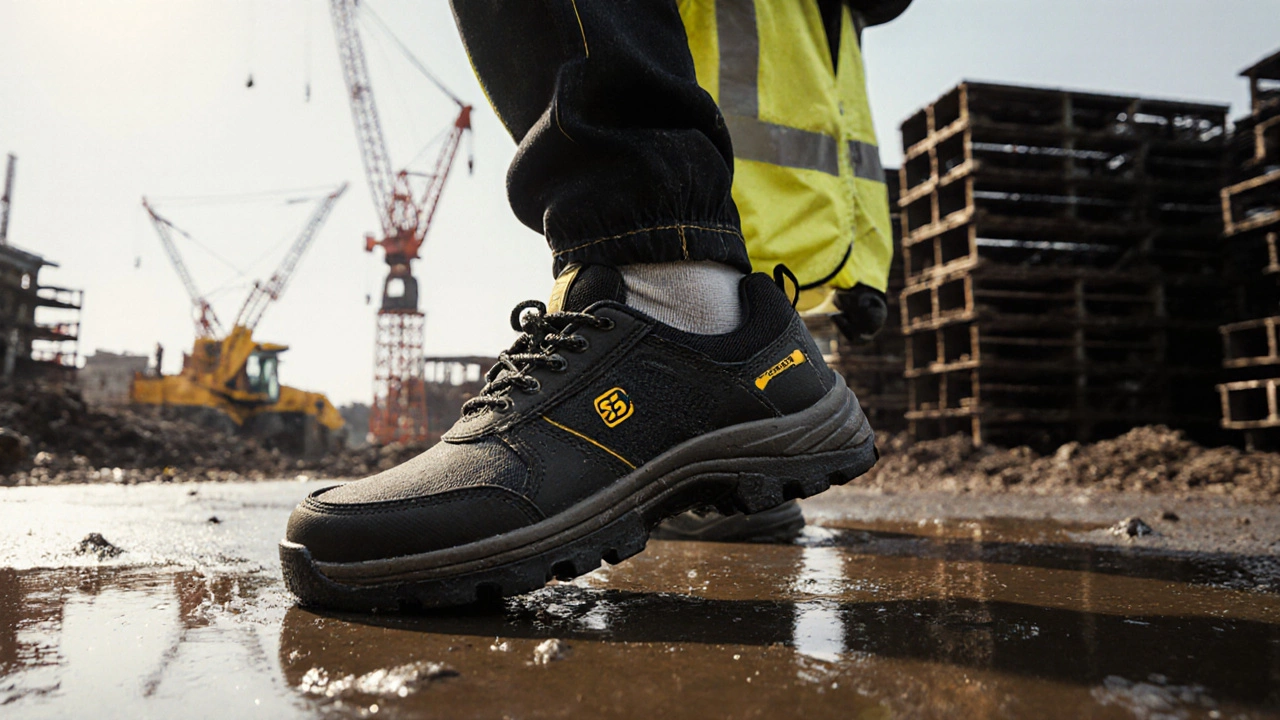Safety Shoe Selector
Determine Your Footwear Needs
Select your job type and potential hazards to find out if you need certified safety shoes or if work shoes are sufficient.
Safety Shoes Required
Your work environment requires certified safety shoes to meet UK/EU safety standards (EN ISO 20345).
Wearing work shoes in this environment may void insurance and expose you to injury risk.
Work Shoes Are Sufficient
Your job doesn't require certified safety shoes, but comfort and durability are important.
Work shoes typically cost £40-£100 and last longer in light-duty environments.
Many people use the terms safety shoes and work shoes interchangeably, but they’re not the same. If you’re buying footwear for a job site, warehouse, or construction zone, picking the wrong type could put you at risk-or cost you money. Knowing the difference isn’t just helpful; it’s essential.
Safety Shoes Are Built to Protect
Safety shoes are designed to meet strict safety standards. They’re not just tough-they’re engineered to prevent injury. In the UK, they must comply with EN ISO 20345, the European standard for protective footwear. That means every pair has to pass tests for impact resistance, compression, slip resistance, and more.
Look for a safety shoe and you’ll see a label with a pictogram and a code like S3. That tells you it has a steel or composite toe cap (protects against 200 joules of impact), a midsole that resists penetration from nails or glass, and a sole designed to grip wet or oily surfaces. Some even have anti-static properties or insulation against heat.
Think of safety shoes as personal protective equipment (PPE), like a helmet or gloves. They’re required in environments where falling objects, heavy machinery, sharp materials, or electrical hazards are present. A construction worker, welder, or factory operator doesn’t just wear them for comfort-they wear them because the law says they must.
Work Shoes Are About Comfort and Durability
Work shoes, on the other hand, are made for people who spend long hours on their feet but don’t face the same level of physical danger. Think retail staff, warehouse pickers, kitchen workers, or delivery drivers. These shoes focus on cushioning, arch support, and breathability.
They might have reinforced toes or rubber soles, but they don’t meet the official safety standards. A work shoe might have a steel toe, but if it hasn’t been certified to EN ISO 20345, it’s not a safety shoe. It’s just a sturdy shoe with a bit of extra protection.
Brands like Clarks, Ecco, and Rockport make work shoes that are popular in offices, call centers, and light industrial settings. They’re designed to reduce foot fatigue, not to stop a 50-pound pipe from crushing your toes.
Key Differences at a Glance
Here’s what separates them in real-world terms:
| Feature | Safety Shoes | Work Shoes |
|---|---|---|
| Compliance Standard | EN ISO 20345 (mandatory in EU/UK) | No mandatory standard |
| Toe Protection | Steel or composite toe cap (tested to 200J impact) | May have reinforced toe, but not certified |
| Puncture Resistance | Midsole protects against nails, glass, sharp objects | Usually not included |
| Sole Grip | Oil- and slip-resistant rubber, tested on wet surfaces | Decent grip, but not tested to safety standards |
| Electrical Hazard Protection | Available in certified models (S1P, S3) | Rarely included |
| When Required | Construction, manufacturing, logistics, welding | Retail, hospitality, light warehousing, admin roles |

What Happens If You Wear the Wrong Ones?
Wearing work shoes on a job site that requires safety footwear isn’t just risky-it can get you in trouble. Employers in the UK are legally required under the Personal Protective Equipment at Work Regulations 1992 to provide appropriate PPE. If you’re injured because you didn’t wear certified safety shoes, your employer might not be liable. Insurance claims can be denied.
On the flip side, wearing heavy safety shoes in a retail store or office can lead to discomfort. They’re often heavier, less flexible, and less breathable than work shoes. You’ll feel the difference after eight hours on your feet.
How to Tell Them Apart
When shopping, don’t rely on marketing terms like "heavy-duty" or "industrial-grade." Look for the official certification. On the shoe, you should see:
- A CE mark
- The EN ISO 20345 label
- A class code: S1, S1P, S2, S3 (each means different levels of protection)
- A pictogram showing a foot with a drop and a puncture mark
If you don’t see these, it’s not a safety shoe-even if it looks rugged. Some brands sell "safety-style" work shoes that mimic the look but lack certification. They’re fine for casual work environments, but not for high-risk zones.
When You Need Safety Shoes
You need safety shoes if your job involves:
- Handling heavy tools or materials
- Working near forklifts or machinery
- Working on construction sites
- Handling hot metals or chemicals
- Working in environments with sharp debris
- Working where slip hazards are common (oil, water, grease)
If your employer provides safety shoes, they’re legally obligated to replace them if they wear out. Don’t wait until your toes are bruised or your sole is cracked-get them checked regularly.

When Work Shoes Are Enough
Work shoes are the right choice if you:
- Stand for long shifts in a store or restaurant
- Walk a lot during your day but don’t handle heavy objects
- Work in an office with a warehouse floor
- Need all-day comfort without the weight of steel
- Have foot conditions like plantar fasciitis and need arch support
Many work shoes now come with memory foam, shock-absorbing midsoles, and moisture-wicking linings. They’re designed for endurance, not impact resistance.
Price and Longevity
Safety shoes typically cost between £60 and £150, depending on the brand and features. They last 6-12 months in heavy use. Work shoes range from £40 to £100 and can last longer if you’re not on rough terrain.
Don’t confuse price with protection. A £150 safety shoe isn’t better than a £70 one if both meet the same standard. Look for certification, not brand names.
What to Do If You’re Not Sure
If your job isn’t clearly defined, ask your employer or safety officer. They should have a risk assessment that tells you exactly what footwear is required. If you’re self-employed, check the Health and Safety Executive (HSE) guidelines for your industry.
When in doubt, go with safety shoes. They’re heavier and less comfortable, but they can literally save your toes. It’s better to wear something slightly less comfortable than something that fails when it matters most.
Can work shoes have steel toes?
Yes, some work shoes have steel toes, but unless they’re certified to EN ISO 20345, they’re not safety shoes. The steel toe alone doesn’t make them protective footwear. Certification means the whole shoe-sole, midsole, stitching, and materials-has been tested under strict conditions.
Are safety shoes only for men?
No. Safety shoes come in a wide range of sizes and fits for all genders. Many brands now offer women’s-specific models with narrower heels and contoured arches. Look for styles labeled as women’s or unisex-they’re designed for comfort and protection regardless of gender.
Can I wear safety shoes every day, even off the job?
You can, but they’re not ideal for casual use. Safety shoes are heavier, stiffer, and less breathable than regular footwear. Wearing them all day outside of work can cause foot fatigue and discomfort. They’re designed for protection, not all-day comfort.
Do safety shoes need to be replaced after a certain time?
Yes. Even if they look fine, safety shoes should be replaced every 6 to 12 months in high-use environments. The toe cap can shift, the sole can wear thin, and the midsole can lose its puncture resistance. Never wait until you feel pain or see visible damage-by then, protection may already be gone.
Are composite toes better than steel toes?
Composite toes are lighter and non-metallic, so they’re better for workers who go through metal detectors often, like airport staff or those in electronics manufacturing. They offer the same impact protection as steel but are less conductive and more comfortable in cold weather. Steel toes are more durable and cheaper, so they’re still the most common choice.

